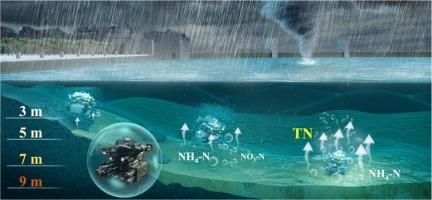Typhoon-induced depth-dependent nitrogen release from reservoir sediments: Insights from high-resolution ROV monitoring
IF 6.3
1区 地球科学
Q1 ENGINEERING, CIVIL
引用次数: 0
Abstract
Typhoon-induced extreme rainfall events have become more frequent recently due to climate change. However, their specific effects on endogenous nitrogen release at the sediment–water interface, particularly in deep-water environments, remain poorly understood. Using a custom remotely operated vehicle (ROV), we conducted high-frequency underwater sampling and real-time monitoring of depth-dependent sediment nitrogen (TN, NH4-N, NO3-N) release from July to October 2023 in Gankeng Reservoir (Shenzhen, China), spanning a once-in-a-century typhoon rainstorm. In deep sediments (7–9 m), TN and NH4-N concentrations in pore water increased sharply, 2.2 to 4.8 times above pre-typhoon levels, while NO3-N in shallow sediments (3–5 m) decreased significantly. Although hydrochemical parameters returned to pre-storm levels within 43 days, TN and NH4-N in deep pore water remained ∼20 % higher than before the event. Analyses of nitrogen speciation, enzyme activity, and correlations indicate that enhanced NH4-N release was driven by typhoon-induced shifts in hydrochemistry and microbial activity. PCA and hierarchical clustering further highlight distinct nitrogen release patterns between shallow and deep sediments. These findings demonstrate that typhoon rainstorms can substantially accelerate TN and NH4-N emissions from sediments, offering critical insights for proactive water quality management to mitigate endogenous eutrophication risks in reservoirs under a changing climate.

台风引起的水库沉积物深度依赖氮释放:来自高分辨率ROV监测的见解
近年来,受气候变化影响,台风引发的极端降雨事件日益频繁。然而,它们对沉积物-水界面,特别是深水环境中内源性氮释放的具体影响仍然知之甚少。2023年7月至10月,在深圳干坑水库进行了一次百年一遇的台风暴雨期间的高频水下采样和深度相关沉积物氮(TN、NH4-N、NO3-N)释放的实时监测。深层沉积物(7 ~ 9 m)孔隙水TN和NH4-N浓度急剧上升,是台风前的2.2 ~ 4.8倍,而浅层沉积物(3 ~ 5 m) NO3-N浓度显著下降。尽管水化学参数在43天内恢复到风暴前的水平,但深层孔隙水中的TN和NH4-N仍比风暴前高约20%。对氮形态、酶活性及其相关性的分析表明,台风引起的水化学和微生物活性变化驱动了NH4-N释放的增加。主成分分析和分层聚类进一步突出了浅层和深层沉积物氮释放模式的差异。这些研究结果表明,台风暴雨可以显著加速沉积物中TN和NH4-N的排放,为气候变化下主动水质管理减轻水库内源性富营养化风险提供了重要见解。
本文章由计算机程序翻译,如有差异,请以英文原文为准。
求助全文
约1分钟内获得全文
求助全文
来源期刊

Journal of Hydrology
地学-地球科学综合
CiteScore
11.00
自引率
12.50%
发文量
1309
审稿时长
7.5 months
期刊介绍:
The Journal of Hydrology publishes original research papers and comprehensive reviews in all the subfields of the hydrological sciences including water based management and policy issues that impact on economics and society. These comprise, but are not limited to the physical, chemical, biogeochemical, stochastic and systems aspects of surface and groundwater hydrology, hydrometeorology and hydrogeology. Relevant topics incorporating the insights and methodologies of disciplines such as climatology, water resource systems, hydraulics, agrohydrology, geomorphology, soil science, instrumentation and remote sensing, civil and environmental engineering are included. Social science perspectives on hydrological problems such as resource and ecological economics, environmental sociology, psychology and behavioural science, management and policy analysis are also invited. Multi-and interdisciplinary analyses of hydrological problems are within scope. The science published in the Journal of Hydrology is relevant to catchment scales rather than exclusively to a local scale or site.
 求助内容:
求助内容: 应助结果提醒方式:
应助结果提醒方式:


